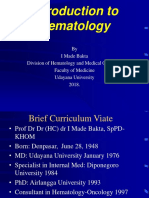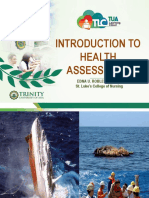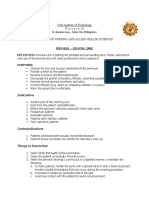100%(1)100% found this document useful (1 vote)
69 viewsObstetrics & Gynecology: Course Objectives
Obstetrics & Gynecology: Course Objectives
Uploaded by
pavi7muruganathanThis document outlines the course objectives and topics for a 12-week course in obstetrics and gynecology. The 13 objectives cover participating in reproductive health programs, diagnosing and managing common obstetric and gynecological disorders, counseling patients, and handling related legal and ethical issues. The course is taught by 4 faculty members and covers topics such as normal pregnancy management, labor, menstrual disorders, gynecological symptoms, pregnancy complications, and abnormal labor.
Copyright:
© All Rights Reserved
Available Formats
Download as PDF, TXT or read online from Scribd
Obstetrics & Gynecology: Course Objectives
Obstetrics & Gynecology: Course Objectives
Uploaded by
pavi7muruganathan100%(1)100% found this document useful (1 vote)
69 views3 pagesThis document outlines the course objectives and topics for a 12-week course in obstetrics and gynecology. The 13 objectives cover participating in reproductive health programs, diagnosing and managing common obstetric and gynecological disorders, counseling patients, and handling related legal and ethical issues. The course is taught by 4 faculty members and covers topics such as normal pregnancy management, labor, menstrual disorders, gynecological symptoms, pregnancy complications, and abnormal labor.
Original Description:
protocol
Original Title
OBG
Copyright
© © All Rights Reserved
Available Formats
PDF, TXT or read online from Scribd
Share this document
Did you find this document useful?
Is this content inappropriate?
This document outlines the course objectives and topics for a 12-week course in obstetrics and gynecology. The 13 objectives cover participating in reproductive health programs, diagnosing and managing common obstetric and gynecological disorders, counseling patients, and handling related legal and ethical issues. The course is taught by 4 faculty members and covers topics such as normal pregnancy management, labor, menstrual disorders, gynecological symptoms, pregnancy complications, and abnormal labor.
Copyright:
© All Rights Reserved
Available Formats
Download as PDF, TXT or read online from Scribd
Download as pdf or txt
100%(1)100% found this document useful (1 vote)
69 views3 pagesObstetrics & Gynecology: Course Objectives
Obstetrics & Gynecology: Course Objectives
Uploaded by
pavi7muruganathanThis document outlines the course objectives and topics for a 12-week course in obstetrics and gynecology. The 13 objectives cover participating in reproductive health programs, diagnosing and managing common obstetric and gynecological disorders, counseling patients, and handling related legal and ethical issues. The course is taught by 4 faculty members and covers topics such as normal pregnancy management, labor, menstrual disorders, gynecological symptoms, pregnancy complications, and abnormal labor.
Copyright:
© All Rights Reserved
Available Formats
Download as PDF, TXT or read online from Scribd
Download as pdf or txt
You are on page 1of 3
3.
OBSTETRICS & GYNECOLOGY
COURSE OBJECTIVES:
At the end of the course the student should be able to:
1. Participate in all national health programs and policies related to reproductive
health and safe motherhood.
2. Define terms commonly used in obstetrics and gynecology.
3. Demonstrate skills of history taking and performing obstetric and gynecological
examination in order to arrive at a logical diagnosis.
4. Recognize clinical features of common obstetric and gynecological disorders
correlate these with etio-pathology and institute primary management.
5. Diagnose pregnancy and provide antenatal, natal, post-natal and essential newborn
care.
6. Identify high risk pregnancy, provide primary care and refer to appropriate medical
centres.
7. Prescribe drugs judiciously during pregnancy and lactation.
8. Screen women for genital and breast cancer for early diagnosis and prevention.
9. Counsel and guide patients and family regarding illness, care, possible complications
and prognosis.
10. Counsel couples and provide fertility regulation.
11. Acquire and practise communication skills required for taking informed consent and
providing reproductive health care to women.
12. Handle medico-legal and ethical issues related to obstetrics and gynecology.
13. Diagnose and provide primary care of common obstetric and gynecological
emergencies.
Course Duration: 12 Weeks
Faculty:
Dr.Lucio Pedro - HoD
Dr. Geremias De Oliveira Rangel
Dr. Ahmad R N Rozan
Dr. Narine Singh
Topics:
I. Introduction to obstetrics and gynaecology
1. Terms used in obstetrics, gynaecology and fertility
regulation.
2. Demography
3. National health policy for reproductive health care and safe motherhood.
II. Management of Normal Pregnancy
1. Development of placenta and development and growth of foetus.
2. Maternal adaptation to pregnancy.
3. Diagnosis of pregnancy.
4. Screening for high risk pregnancy.
5. Fetal surveillance for growth and well being.
III. Management during labour
1. Mechanism of normal labour.
2. Intrapartum monitoring and use of partogram.
3. Pain relief during labour.
4. Management of normal delivery.
5. Management of third stage.
IV. Menstrual function and dysfunction
1. Menstrual disorders
2. Dysmenorrhoea
3. Abnormalities of menarche and menopause
V. Common Gynecological Symptoms
1. Vaginal discharge
2. Pain abdomen.
3. Abdominal mass.
4. Utero-vaginal prolapse.
VI. Complications in Pregnancy Complications of early Pregnancy Abortions
1. Abortions
2. Ectopic pregnancy
3. Gestational trophoblastic tumors
4. Hyperemesis gravidarum
5. Retention of urine
6. Multiple pregnancy
7. Malpresentations
8. Antepartum Haemorrhage
9. Pregnancy induced hypertension and eclampsia
10. Pretem labour and premature rupture of membranes.
11. Intracuterine growth retardation.
12. Rh isoimmunisation.
13. Intrauterine fetal death
14. Repeated pregnancy loss.
15. Anaemia
16. Hypertensive disorders
17. Renal disorders
18. Cardio vascular disorders
19. Diabeties mellitus
20. Jaundice
21. Malaria
22. Tuberculosis
23. Syphilis
24. TORCH infections
25. AIDS
VII. Abnormal Labour
1. Prolonged labour
2. Obstructed labour
3. Assisted delivery
4. Breech delivery
5. Forceps delivery
6. Vento use delivery
Caesarean section
7. Version (I.P.V.)
8. Destructive operations
9. Post partum haemorrhage
10. Manual removal of placenta
11. Birth canal injuries
You might also like
- 07 - Partograph - GLG20140212Document50 pages07 - Partograph - GLG20140212Geline Joy D. SamillanoNo ratings yet
- Obstetric Nursing & Midwifery 2 Course OutlineDocument2 pagesObstetric Nursing & Midwifery 2 Course OutlineCrevins NyarikiNo ratings yet
- de Swiet's Medical Disorders in Obstetric PracticeFrom Everandde Swiet's Medical Disorders in Obstetric PracticeRaymond PowrieNo ratings yet
- Introduction To Obstetrics and GynaecologyDocument50 pagesIntroduction To Obstetrics and GynaecologySavita Hanamsagar100% (1)
- Lecture Notes On AphDocument41 pagesLecture Notes On AphEyob MizanNo ratings yet
- Ectopic PregnancyDocument36 pagesEctopic PregnancyLorenz BreezNo ratings yet
- Disorders of Endocrine GlandDocument14 pagesDisorders of Endocrine Glandaklimaetsy1099No ratings yet
- Fetal CirculationDocument19 pagesFetal CirculationAlozie PrestigeNo ratings yet
- Fetal Growth and DevelopmentDocument3 pagesFetal Growth and DevelopmentAngel Shaina VillanuevaNo ratings yet
- Drugs in ObstetricsDocument95 pagesDrugs in ObstetricsPriya jNo ratings yet
- Why Is Cultural Knowledge Important To Nurses?: Cultural Competency in NursingDocument4 pagesWhy Is Cultural Knowledge Important To Nurses?: Cultural Competency in NursingFitriia SariiNo ratings yet
- Diarrhea: ChildrenDocument16 pagesDiarrhea: ChildrenEmmi Valentina PardedeNo ratings yet
- Case Study CLD 3Document18 pagesCase Study CLD 3MoonNo ratings yet
- Essential Medicine Concept and Rational Use of DrugsDocument16 pagesEssential Medicine Concept and Rational Use of DrugsDixa MeNo ratings yet
- Presentation 2Document49 pagesPresentation 2Wahyu Adhitya Prawirasatra100% (2)
- NG TubeDocument3 pagesNG TubeBitew Tefera ZewudieNo ratings yet
- Assessment of Knowledge, Attitude, and Practice of Self-Medication Among Harar Health Sciences College Students, Harar, Eastern EthiopiaDocument6 pagesAssessment of Knowledge, Attitude, and Practice of Self-Medication Among Harar Health Sciences College Students, Harar, Eastern EthiopiaAzra SyafiraNo ratings yet
- Narcotic DrugDocument34 pagesNarcotic Drugtshiringtmg7No ratings yet
- Introduction (Unit 1)Document24 pagesIntroduction (Unit 1)anju kumawatNo ratings yet
- Body TemperatureDocument26 pagesBody TemperatureChinniah RamkumarNo ratings yet
- Introduction To HematologyDocument61 pagesIntroduction To HematologyThis is PonyNo ratings yet
- Patient Rights & Organizational EthicsDocument17 pagesPatient Rights & Organizational EthicsBOnn EljayNo ratings yet
- Lymphatic System Anatomy and Physiology - NurseslabsDocument35 pagesLymphatic System Anatomy and Physiology - NurseslabsAlyssum MarieNo ratings yet
- Abruptio Placenta and AbortionDocument10 pagesAbruptio Placenta and Abortiondanica grace gubaNo ratings yet
- Presentation Abnormal PuerperiumDocument52 pagesPresentation Abnormal PuerperiumTesfaye AbebeNo ratings yet
- Advantages of Breast FeedingDocument4 pagesAdvantages of Breast FeedingRollan MaulasNo ratings yet
- Presentation On: Female Reproductive SystemDocument54 pagesPresentation On: Female Reproductive SystemLetsShop BbsrNo ratings yet
- 15 - Digestive System Anatomy and Physiology SeriesDocument101 pages15 - Digestive System Anatomy and Physiology SeriesIsaac Kipkemoi100% (1)
- KON HandbookDocument78 pagesKON HandbookRasyad KamalNo ratings yet
- Shoulder DystociaDocument14 pagesShoulder Dystociarake sardevaNo ratings yet
- Premature Rupture of The MembranesDocument6 pagesPremature Rupture of The MembranesMaria Donabella OngueNo ratings yet
- Anatomo-Physiological Peculiarities of The Respiratory System. Percussion of The Lungs.Document40 pagesAnatomo-Physiological Peculiarities of The Respiratory System. Percussion of The Lungs.Hetvi PatelNo ratings yet
- Preoperative Preparation of Patient For SurgeryDocument23 pagesPreoperative Preparation of Patient For SurgeryFauzi SebunyaNo ratings yet
- Ostomy CareDocument3 pagesOstomy CareSyamsul ArifinNo ratings yet
- 10 Golden Rules of IV TherapyDocument8 pages10 Golden Rules of IV Therapybbasya eihynaNo ratings yet
- Kangeroo Care Final 1Document22 pagesKangeroo Care Final 1api-438174007No ratings yet
- Postpartum HaemorrhageDocument26 pagesPostpartum HaemorrhagePriyanka ViswanathNo ratings yet
- Introduction To Oncology NursingDocument189 pagesIntroduction To Oncology NursingyewollolijfikreNo ratings yet
- Abnormalities of Labour and Delivery and Their Management: Joó József GáborDocument44 pagesAbnormalities of Labour and Delivery and Their Management: Joó József GáborAnnisa Mutiara InsaniNo ratings yet
- 4normal Labour and DeliveryDocument90 pages4normal Labour and DeliveryGabriel ZuñigaNo ratings yet
- Maternal and Child Health (MCH)Document20 pagesMaternal and Child Health (MCH)Redw AnNo ratings yet
- Presentation EpilepsyDocument38 pagesPresentation EpilepsypertinenteNo ratings yet
- Code of Ethics For NursesDocument5 pagesCode of Ethics For NursesAmina Abba HaliruNo ratings yet
- Trends & Issues in MSN NursingDocument41 pagesTrends & Issues in MSN NursingRajesh Sharma100% (3)
- 1 - Fetal Physiology and The Transition To Extrauterine LifeDocument13 pages1 - Fetal Physiology and The Transition To Extrauterine LifeRonaldo Pineda WieselbergNo ratings yet
- Drug Nomenclature: MR - Manikanta TMCDocument5 pagesDrug Nomenclature: MR - Manikanta TMCManikanta GupthaNo ratings yet
- Newborn Clinical QuizDocument5 pagesNewborn Clinical QuizAmy100% (1)
- Who Par To GraphDocument59 pagesWho Par To GraphHandri Rezki VebrianNo ratings yet
- YAWS: Elimination To EradicationDocument5 pagesYAWS: Elimination To EradicationShrutiNo ratings yet
- Guidelines - Safe - Surgery MOH PDFDocument97 pagesGuidelines - Safe - Surgery MOH PDFlisaNo ratings yet
- Child Health Nursing NotesDocument9 pagesChild Health Nursing NotesBindhu RaniNo ratings yet
- NEPHROSISDocument31 pagesNEPHROSISvinnu kalyanNo ratings yet
- SANDRA, Apollo OBG Minor Disorders in Neonates PPT - SECTION BDocument15 pagesSANDRA, Apollo OBG Minor Disorders in Neonates PPT - SECTION Bsandra0% (1)
- Drug Use During Pregnancy and LactationDocument50 pagesDrug Use During Pregnancy and LactationJuveria Fatima75% (4)
- MastitisDocument35 pagesMastitisRestu AWNo ratings yet
- Health Assessment IntroductionDocument50 pagesHealth Assessment IntroductionEdna Uneta RoblesNo ratings yet
- Hypertrophy Pyloric StenosisDocument7 pagesHypertrophy Pyloric StenosismacmohitNo ratings yet
- Related Protocols / Related Links Include:: Lumbar Puncture in The NeonateDocument7 pagesRelated Protocols / Related Links Include:: Lumbar Puncture in The NeonateJairo Camilo Guevara FaríasNo ratings yet
- Role of Dietary Fibers and Nutraceuticals in Preventing DiseasesFrom EverandRole of Dietary Fibers and Nutraceuticals in Preventing DiseasesRating: 5 out of 5 stars5/5 (1)
- Physio INI PYTDocument4 pagesPhysio INI PYTpavi7muruganathanNo ratings yet
- Anat RR 1Document24 pagesAnat RR 1pavi7muruganathanNo ratings yet
- Notification Assistant Surgeon GeneralDocument25 pagesNotification Assistant Surgeon Generalpavi7muruganathanNo ratings yet
- All India Institute of Medical SciencesDocument1 pageAll India Institute of Medical Sciencespavi7muruganathanNo ratings yet
- 15A ArteryDocument72 pages15A Arterypavi7muruganathanNo ratings yet
- OnlineEC Instruction MDMS 2022 23Document2 pagesOnlineEC Instruction MDMS 2022 23pavi7muruganathanNo ratings yet
- Cleavage and ImplantationDocument20 pagesCleavage and Implantationpavi7muruganathanNo ratings yet
- 2-Complications of Pregnancy Pt1Document37 pages2-Complications of Pregnancy Pt1pavi7muruganathanNo ratings yet
- Development Urinary SystemDocument33 pagesDevelopment Urinary Systempavi7muruganathan75% (4)
- Hypertensive Diseases in Pregnancy: DR Lucio Pedro DM MD FacogDocument32 pagesHypertensive Diseases in Pregnancy: DR Lucio Pedro DM MD Facogpavi7muruganathanNo ratings yet
- AsphyxiaDocument48 pagesAsphyxiapavi7muruganathanNo ratings yet
- AsphyxiaDocument19 pagesAsphyxiapavi7muruganathanNo ratings yet
- Specialties 250 SBAs For FinalsDocument292 pagesSpecialties 250 SBAs For FinalsSiddharth BasettiNo ratings yet
- Remineralization of TeethDocument37 pagesRemineralization of TeethPrajakta ChavanNo ratings yet
- Tle 8 3RD Quarter CaregivingDocument43 pagesTle 8 3RD Quarter CaregivingOdessa MarohomsalicNo ratings yet
- IAE 102 5s and Safety PracticesDocument5 pagesIAE 102 5s and Safety PracticesChristian Lumactod EmbolodeNo ratings yet
- Capstone - School BasedDocument18 pagesCapstone - School Basedapi-753769736No ratings yet
- Orem TheoryDocument34 pagesOrem TheoryTerefe KetoNo ratings yet
- A Study On Impact of COVID-19 Lockdown On Psychological Health, Economy and Social Life of People in KashmirDocument12 pagesA Study On Impact of COVID-19 Lockdown On Psychological Health, Economy and Social Life of People in KashmirDavit SoesantoNo ratings yet
- Paul Thomas ComplaintDocument37 pagesPaul Thomas ComplaintChris BjorkeNo ratings yet
- Precipitating Factors Predisposing Factors: Sitting Down or Lying Down For Too Long ObesityDocument1 pagePrecipitating Factors Predisposing Factors: Sitting Down or Lying Down For Too Long ObesitySureen RegularNo ratings yet
- Dr. Lisa PPT Burn Injury Revisi OkDocument35 pagesDr. Lisa PPT Burn Injury Revisi OkRsud Malinau Ppk BludNo ratings yet
- Article - 1653239529 2Document5 pagesArticle - 1653239529 2Mega AzzahraNo ratings yet
- Neural Tube DefectsDocument40 pagesNeural Tube Defectsmdy0xxNo ratings yet
- Architect c4000 PresentationDocument20 pagesArchitect c4000 Presentationapi-649553353No ratings yet
- DMO Martindale - 2014Document4 pagesDMO Martindale - 2014mgkyawthuhlaingNo ratings yet
- Baru 414.2.full PDFDocument6 pagesBaru 414.2.full PDFIrmagian PaleonNo ratings yet
- Strat OG SBA 2018 ObstetricsDocument175 pagesStrat OG SBA 2018 ObstetricspaymentxewelNo ratings yet
- NCP-Resubmission - Mercado, Alyssa Marie R.Document4 pagesNCP-Resubmission - Mercado, Alyssa Marie R.Alyssa MercadoNo ratings yet
- Cebu Institute of Technology University N. Bacalso Ave., Cebu City Philippines College of Nursing and Allied Health SciencesDocument4 pagesCebu Institute of Technology University N. Bacalso Ave., Cebu City Philippines College of Nursing and Allied Health SciencesMikha BorcesNo ratings yet
- Orthodontic Indices PDFDocument112 pagesOrthodontic Indices PDFDr.khalandar khatibNo ratings yet
- Hiv & StiDocument46 pagesHiv & StiMites Bustamante Dela CruzNo ratings yet
- NCP Midterm Uncontrolled DMDocument7 pagesNCP Midterm Uncontrolled DMYlron John TaparNo ratings yet
- Glacoma What You Should KnowDocument26 pagesGlacoma What You Should KnowTaranisaNo ratings yet
- Pag 80-81Document2 pagesPag 80-81Lauri Rosse100% (1)
- Welcome To COVID Vaccine Dystopia.Document64 pagesWelcome To COVID Vaccine Dystopia.Joel S. Hirschhorn100% (1)
- 3 Week Review StudyPlanDocument2 pages3 Week Review StudyPlanSNo ratings yet
- Seizure: Health Education HFT 201 By: Sophia Kol, MDDocument12 pagesSeizure: Health Education HFT 201 By: Sophia Kol, MDTith SeavmeyNo ratings yet
- General Awareness of Pathology With Special Reference To Typhoid DiseaseDocument41 pagesGeneral Awareness of Pathology With Special Reference To Typhoid DiseaseNiveditaPandeyNo ratings yet
- CPC 9 Series QuestionsDocument11 pagesCPC 9 Series QuestionsHaripriya KM0% (1)
- Module 2 - Infectious ProcessDocument3 pagesModule 2 - Infectious ProcessRashid DayaoNo ratings yet
- Awareness Package Outpatient UPDATEDDocument3 pagesAwareness Package Outpatient UPDATEDMikaela PelagioNo ratings yet





































































































